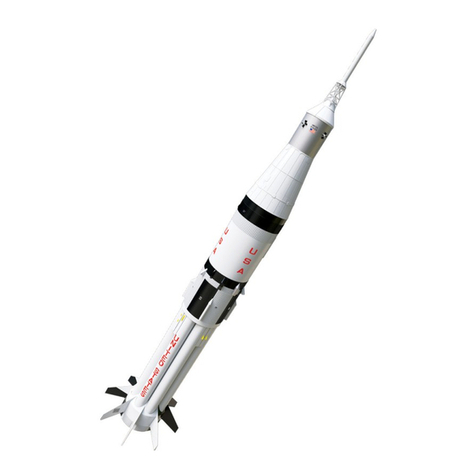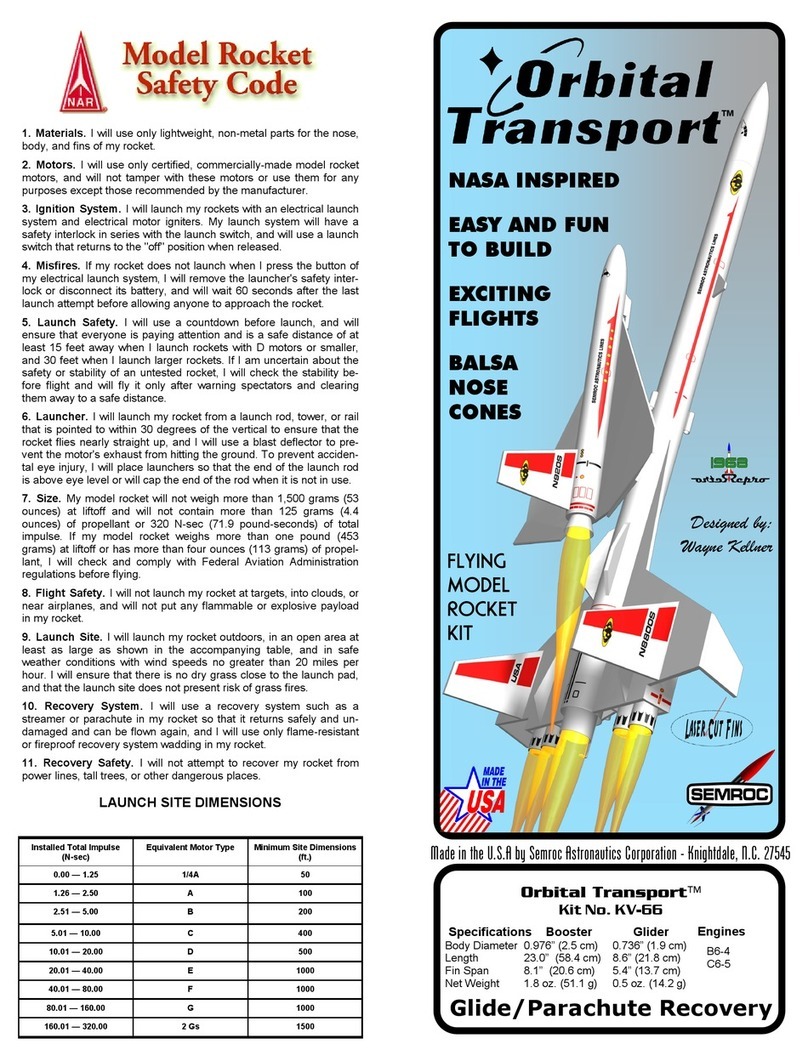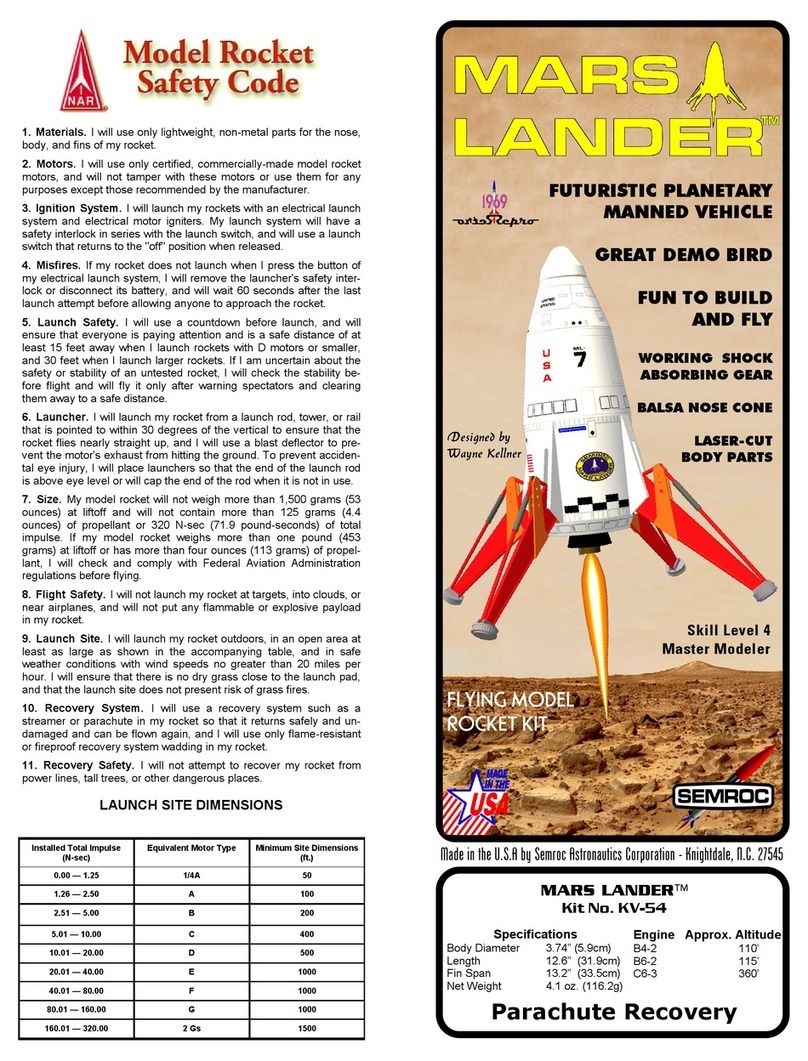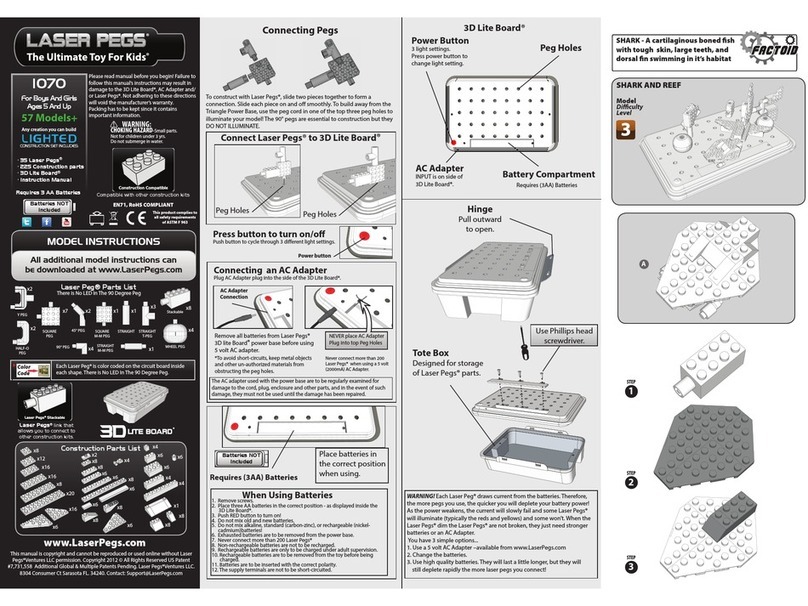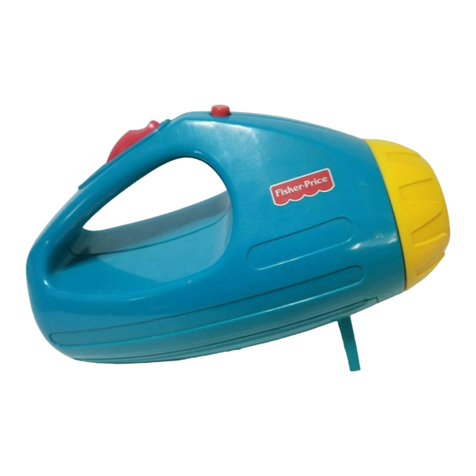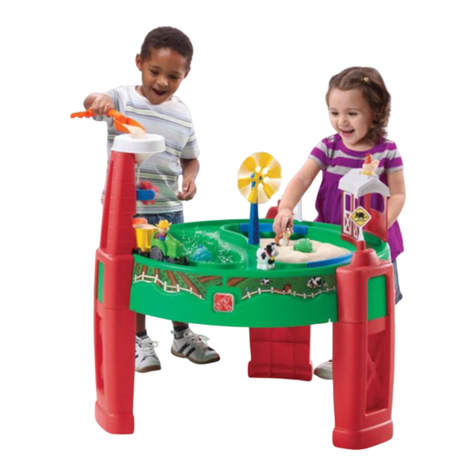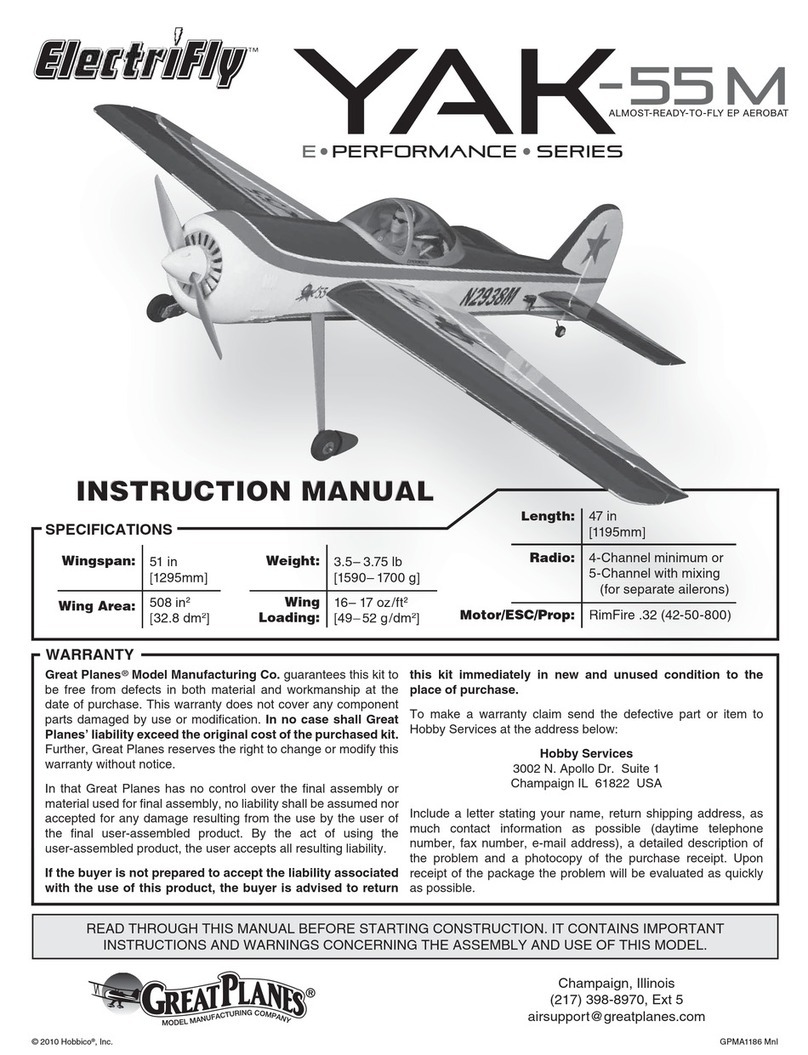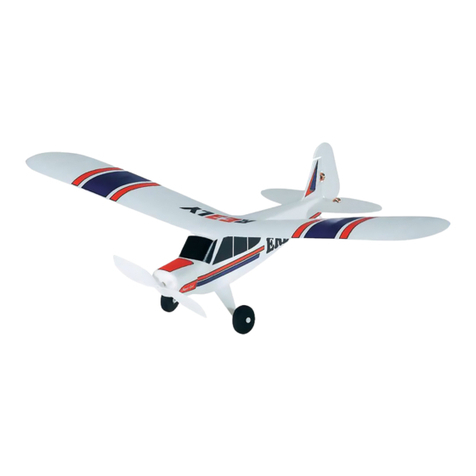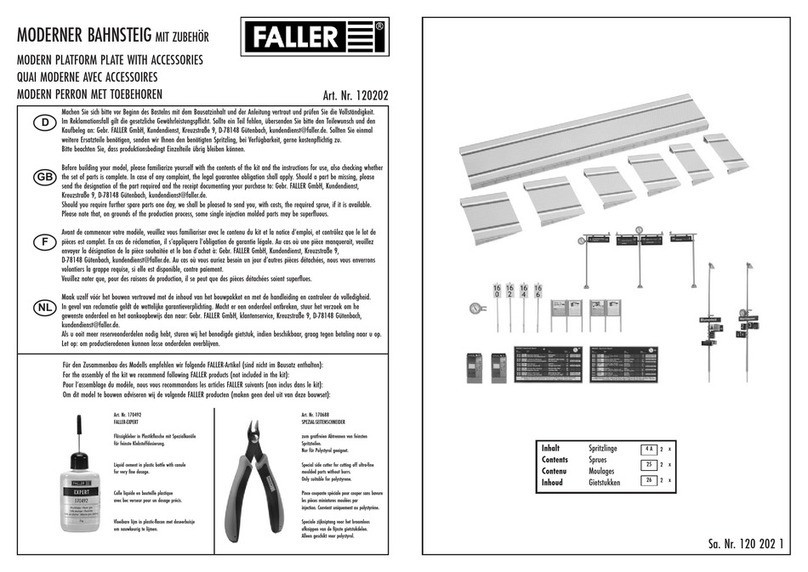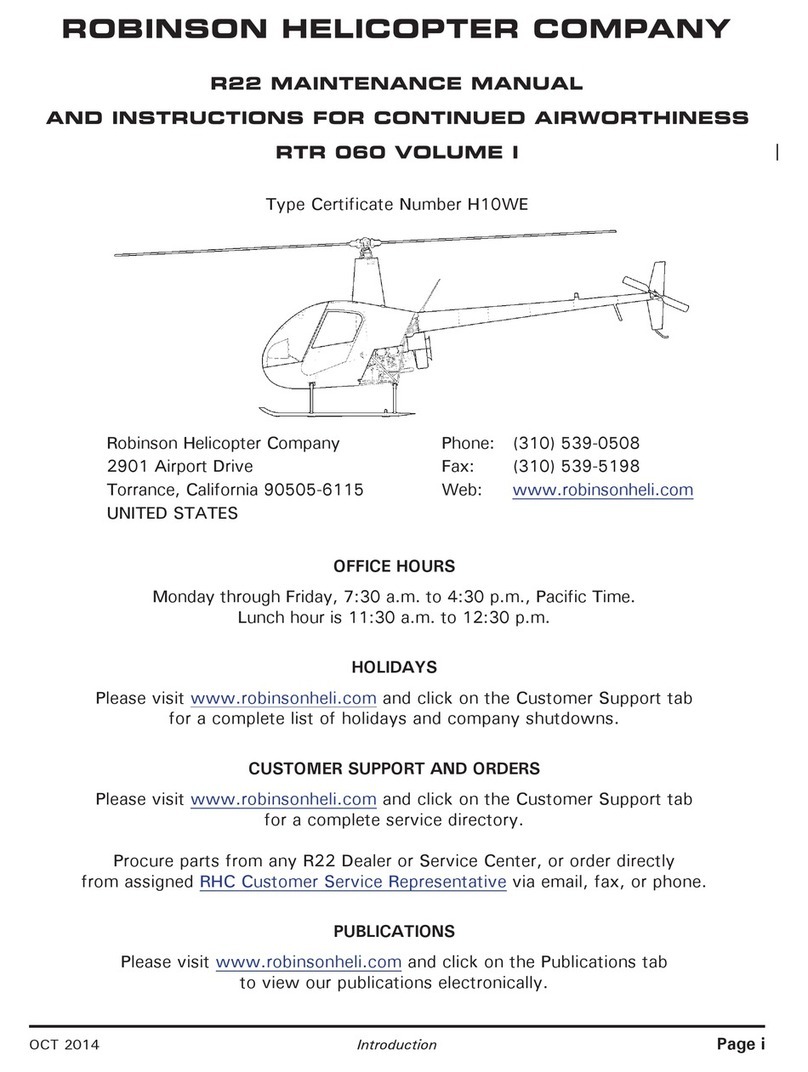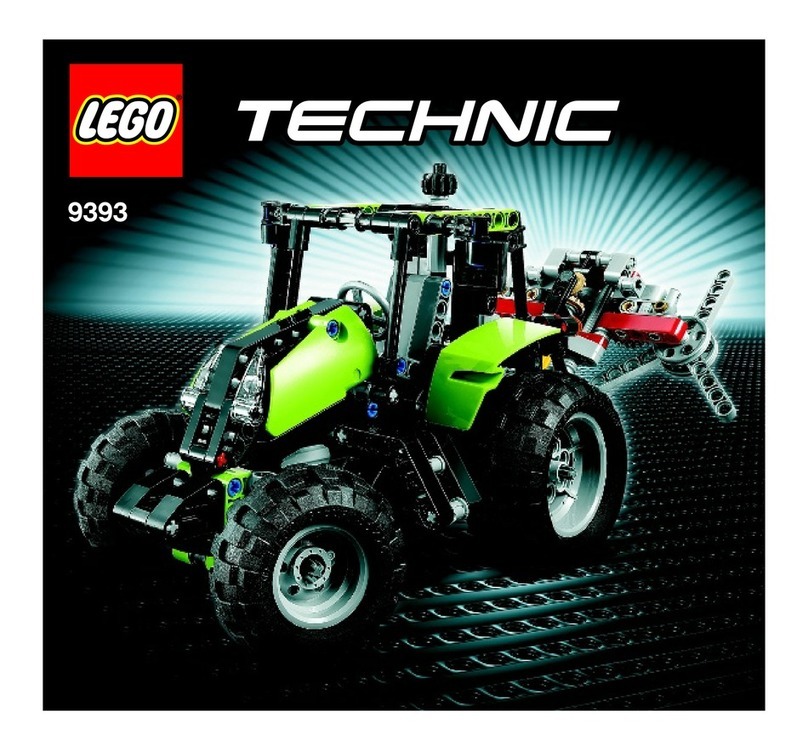SEMROC MX Orbital Transport KMX-01 User manual

Copyright © 2018 Semroc
www.semroc.com
MX Orbital Transport™
Kit No. KMX-01
Engine Approx. Altitude
Micro Maxx 130
’
Skill Level 3
About
Semroc
Semroc Astronautics Corporation was started by
Carl McLawhorn in his college dorm at North Caroli-
na State University in November, 1967. Convincing
a small group of investors in his home town of Ay-
den, North Carolina to invest in a small corporation,
the company was re-incorporated as Semroc Astro-
nautics Corporation on December 31, 1969.
Semroc produced a full line of model rocket kits and
motors. At its peak, Semroc had twenty-five full
time employees working at two facilities. One was
for research and development, printing, shipping,
and administration. The other was outside of town
and handled all production and model rocket motor
manufacturing. For several years, Semroc success-
fully sold model rocket kits, supplies, and motors by
mail-order and in hobby shops. In early 1971, Sem-
roc became insolvent and had to close its doors.
After 31 years of dreams and preparations, Semroc
Astronautics Corporation was reincorporated on
April 2, 2002 with a strong commitment to putting
the fun back into model rocketry. Many years of
excellent service to the rocketry community passed
by until sadly, on August 11 2013, Carl passed away
and left a great void in the hearts of many rocket-
eers. He is forever in our hearts and minds.
In February of 2015, Semroc was sold to eRockets
and moved to Dayton, Ohio where it resides today.
It is our goal to continue the level of service and
dedication to the hobby Carl and his family were so
well known for. We strive to serve you, our custom-
ers, to the best of our abilities as we carry the vision
of Carl McLawhorn boldly into the future.
About the MX Orbital
Transport™
The MX Orbital Transport is a Downscale of the
Estes Orbital Transport that was introduced in Cata-
log #683 in late 1968. It was designed by Wayne
Kellner. The Orbital Transport was based on an ear-
ly NASA scramjet design for the Space Shuttle. The
Orbital Transport was released as Cat. No. K-42 and
had an introductory price of $2.50.
Jay Berry was inspired to engineer the MX Orbital
Transport™ to utilize the Micro Maxx brand of en-
gines. These engines allow MX rockets to be flown
in a smaller flying field for greater recoverability.
EXPLODED VIEW
Specifications
Body Diameter .488” (1.24 cm)
Length 8.625” (21.907 cm)
Fin Span 3.125” (7.9375cm)
Net Weigh 0.189 oz. (5.37 g)
Made in the U.S.A by Semroc - Dayton, Ohio
Downscale of the
Classic Orbital
Transport
Precision Turned
Balsa Nose Cones
Laser Cut
Basswood Fins
Streamer/Glider
Recovery
Water Slide
Decals
™
Engineered by
Jay Berry
MX
A
B
C
D
J
F
G
H
I I
K
L
M
N
O
2
3
4
5
6
7
8
9
10
11
12
13
14
L G
G 1
PARTS LIST
A 1 Balsa Nose Cone ................................BNC-3SC
B 1 Body Tube..........................................BT-3-6.75
C 1 Balsa Nose Cone………………….BNC-2G
D 1 Body Tube……………………….BT-2-2.5
E 1 Laser-cut Fin Set ...............................FMX-01
F 1 Glider Hook Set (2pcs)……………..FMX-01B
G 1 Glider Hook Cover Set……………...LSKMX-01
H 2 Centering Rings..................................RA-2-3
I 4 Launch Lugs……………………..LL-2AM
J 1 Wood Dowel 1/12”x2.5” .......................WD-13
K 1 Motor Tube ........................................BT-2-1.25
L 2 Thrust Block ......................................TB-2
M 1 Kevlar Cord........................................SCK-24
N 1 Streamer Pack ...................................SP-118
O 1 Launch Lug ........................................LL-MX-1
P 1 Decal (Not Shown)..............................DKMX-05
Q 1 Weight Clay (Not Shown)…………...WC-1
R 1 Fin Alignment Tools (5 Pcs)…………TKMX-01
(Not Shown)

❑1. Find the motor tube
and place a mark 1/4’” from
one end of the tube and
1/8” from the opposite end.
Tie a double overhand knot
in the Kevlar shock cord
near one end. See picture at
right to see how to tie the
knot. Trim excess cord off
close to the knot. Put some
glue in the end of the motor
tube marked at 1/8” to hold
the motor thrust block. In-
sert the end of the Kevlar
shock cord with the knot
into the motor tube. Trap
the shock cord between the
thrust block and motor
tube. Push the thrust block
in until it is flush with the
motor tube. Pull Shock cord
until the knot is seated
against the motor block.
Install the two centering
rings onto the motor tube
and glue them at the marks
that were made on the tube.
Set aside to dry.
ASSEMBLY
❑5. Cut the piece of supplied
Streamer material in half
lengthwise. Attach one of these
pieces to the shock cord near
the nose cone with a piece of
Masking Tape as shown. Put
the shock cord, and streamer
into the body tube and put the nose cone in the end of
the body tube to make it easier to handle the complet-
ed body tube before proceeding to the next step.
1/4” 1/8”
You will need the following for your assembly:
Pencil Ruler Knife Wax Paper Wood/Modelers Putty
White or Wood Glue 220 Grit Sandpaper
Medium Viscosity Super Glue Brush or Spray Paint
TOOLS
❑6. Set up all 3 Fin Alignment Jigs so that they will
stand up by themselves. Lay the body tube assembly in
the cradle with 2 of the jigs near the end with the motor
mount tube. Attach the Wing and Wing Fairings to both
sides of the body tube by resting them on the alignment
jigs, keeping them even with the end of the body tube.
The forward Canard Fins (5) can be installed the same
way with the front point of the Canard being 1 3/4” back
from the front end of the body tube. Set aside to dry.
❑2. Using the Fin Sheet
diagram, locate the Wing (1)
and the Wing Fairing (2).
Carefully remove them from
the sheet and glue them
together on a piece of wax
paper. Keep them flat while
they dry. Do this for both
wings.
❑4. Take the toothpick and
push it approximately 1/4 of
the way into the rear end of
the Nose Cone. Make a mark
on the toothpick and then
remove it. Fill the hole with
glue and insert the free end
of the shock cord. Cut the
toothpick at the mark you
made and insert it back into
the hole to hold the shock
cord in place before the glue
dries.
B
A
❑3. Glue the Motor Mount
Tube into the Main Body
Tube (A). Be sure to put the
shock cord through the body
tube before inserting the
motor mount tube. Use the
notch in the Fin Alignment
Tool to set the correct depth
of the motor tube as shown.
INSTALL MOTOR MOUNT
ATTACH NOSE CONE
INSTALL STREAMER
INSTALL FINS
1 3/4” 1 3/4”
❑7. After the wings have dried, find the launch Lug
(O), and put it in two of the Fin Alignment Jigs. Keep
the Jigs at the ends of the Launch Lug. Mark the Main
Body Tube (A) 1 3/4” from the rear end of the tube, (end
with the wings/motor tube). Using Medium Viscosity
Super Glue, attach the lug to the body tube, keeping the
rear of the launch lug even with the mark on the tube
and the jigs flat on the wings/wing fairings . Once dry,
remove jigs and apply glue fillets to wings/wing fair-
ings, and launch lug. Set aside to dry.
Fin Sheet Diagram
1
1 22
3
3
4
4
5
5
6
6
7
7
8 8
9 9
10
10
10
10
11
11
12
12
13
14
14
Stabilizer and Wing
Fence Guide
Fin Alignment Tool
Feet
Launch Lug Position Guide
Motor Tube Position
Slots for Feet
Slots for Feet
Glider Hook
Position Guide
Glider
Elevon
Guide

❑8. Attach the Wing Tips (3)
to the ends of the wings. You
can make sure that these are
perpendicular to the wings by
using one of the square cor-
ners of the fin alignment
guides to check for square-
ness. Make sure the wing tips
are glued on the same side as
the launch lug.
❑10. Find the 4 Scramjet
Tubes (I) and glue them
together in sets of two with
the ends even and the tubes
parallel. While these are
drying find the parts for the
surrounding boxes, parts
(8), (9) and (10) on the Fin
Sheet. Glue part (9) to part
(8) with the tab located in
the slot in the middle of part
(8) as shown and parts (10)
to the sides of part (8) as
shown. Make sure all parts
are perpendicular as they
dry. Glue Scramjet Tubes (I)
in opening behind part (8)
and then glue the assembly
to the wing locating the
tabs in the appropriate
slots. Make sure all parts
are fully seated against
wing. Repeat for other
wing. Set aside to dry.
❑9. Attach the Ventral Fins (7)
to the rear of the body tube
flush with end of the body tube.
These also attach on the same
side as the Launch Lug. Use the
smaller fin locating guide to
position these fins. Use the out-
er slots on this jig for these fins.
BUILD SCRAMJETS
UPPER WING DETAILS
❑11. Locate the Wing
Fences (14) on the Fin Sheet
and glue them to the upper
side of the wings. They are
positioned in the slots di-
rectly above the Scramjet
boxes, one on each wing.
❑12. Locate the Rudders
(4) on the Fin Sheet and
glue them to the upper side
of the wings. They are posi-
tioned in the slots towards
the end of the wings, again,
one on each wing.
❑13 Locate the Glider
Supports (6) on the Fin
Sheet. Make a mark on the
top of the body tube 1 3/16”
from the rear of the body
tube. This will be the rear of
the Glider Supports. Using
the center two slots on the
smaller Fin Positioning
Guide, glue the Glider Sup-
ports to the top of the Body
Tube.
GLIDER SUPPORTS
❑14. Locate one of the
Glider Hooks (F). Make a
mark on the top of the body
tube 3 5/16” from the front
of the body tube. This will
be the front of the Glider
Hook. Glue the Glider Hook
to the top of the Body Tube.
Make sure the Hook is cen-
tered between the Glider
Supports and that the saw-
tooth edges are facing the
front of the rocket.
GLIDER ASSEMBLY
❑15. Lay the Glider Body
Tube (D) on a flat surface.
Place a sheet of wax paper
over it to prevent glue from
sticking while the wings
dry. Place a bead of glue on
the root edge of one of the
Glider Wings (11) and at-
tach it to the other wing. As
the glue joint starts to set,
drape the assembly over
the body tube and wax pa-
per and let the wing tips
rest on the surface to form
the wing dihedral. Let dry.
❑16. Once the wing as-
sembly has dried, take the
Glider Body Tube (D) and
using the Fin Alignment Jig,
mark the Glider Body Tube
for Wing and Rudder place-
ment. Place the Glider Body
Tube in the hole in the Fin
alignment Jig and make a
mark on the tube at the
hash marks that are across
from each other. Extend
these marks the length of
the tube using a door jamb
or angle.
❑17. Glue the wing as-
sembly to the Glider Body
Tube keeping the rear edge
of the wings even with one
end of the body tube, and
the root edges of the wings
centered over one of the
lines that were drawn on
the body tube. Make sure
the wing tips remain on the
surface to keep the correct
wing angle.
❑18. Glue the Glider
Rudder (13) to the top of the
body tube on the other line
you previously marked on
the body tube. Keep the
Rudder even with the same
end of the body tube as the
wings, and lined up with the
joint of the wings on the
bottom of the body tube.
Add glue fillets to all joints.
❑19. Glue the Glider
Elevons (12) to the outer
rear edges of the wings.
Use the large Fin Alignment
Guide to set the angle of the
Elevons.
Glue
Here
Glue Fillets

1/2”
❑20. Get the remaining
Glider Hook (F) and square
up the bottom side where it
will be glued to the under-
side of the glider. Make a
mark on the under side of
the wing 1/2” back from the
point where the two wing
halves join. File or sand a
flat across the wing joint so
the Hook will sit flat and
glue down the Glider Hook.
Make sure the hook is cen-
tered over the joint and is
parallel with the Body Tube,
and the Saw-tooth edge is
facing rearward.
❑21. Glue the aprons to
the sides of the hook. Use a
toothpick to spread the glue
so that you don’t get glue
into the hook area. Once the
glue has dried, lightly sand
the sides of the hook on the
booster and check that the
glider will release freely
when hooked together.
❑22. Cut the Orbiter Noz-
zle from the carrier sheet
and Pre form it into a nozzle
around the end of a sharp-
ened pencil. Once it is to
shape, glue the ends to-
gether with the ends sliding
together in the slot. Set
aside to dry. Glue the disc
to the end of the TB-1+
Thrust Block (L), centering it
over the end of the tube.
When the nozzle is dry,
attach it to the disc, keeping
it centered. When this as-
sembly is dry it can be in-
serted into the rear of the
Orbiter Body Tube. It is
recommended that this not
be glued into place until
after painting, to make it
❑23. Check the fit of the
nose cone in the Orbiter
Body Tube. Do Not Glue to
Body Tube at this time.
Nose cone will be glued in
after glider has been bal-
anced for gliding.
Stall–Add Nose Weight
Good Glide
Dive–Remove Nose
Weight
TRIMMING YOUR GLIDER
❑24. Before you can fly
your glider, it must be bal-
anced correctly. Remove
the nose cone from the
glider and glue the remain-
ing piece of the toothpick
into the rear of the nose
cone. Add a small amount
of clay around the toothpick
and re-insert the nose cone
into the glider without glue. Gently toss the glider and
check how it glides. If it stalls, add more clay. If it dives,
remove some. When it glides straight, it is balanced
correctly. It is best to wait on gluing in the nose cone
until after you have your model painted so that you can
check the glide characteristics and make any modifica-
tions necessary.
FINISHING YOUR MODEL
❑25. Now that you
have completed assem-
bly of your MX Orbital
Transport it is time for
finishing. For best look-
ing results, some filling
and sanding will be re-
quired. Using Carpenters
wood putty or Modelers
putty, fill the areas where
the tabs and slots came
together on the wings,
and sand smooth once it
has dried. Use sanding
sealer on the nose cones
to fill the pores in the
balsa wood. Several
coats may be needed to
get a smooth surface
sanding between coats.
Prime and paint your
model as you see fit and
add decals as shown in
the attached diagram.
FLIGHT PREPPING
❑26. Mounting the engine: Friction fit the Micro Maxx
motor with masking tape applied around it to keep it
from being kicked out of the motor mount at ejection
time.
❑27. Insert recovery wadding into the top of the Main
Body Tube. Use a sufficient amount to protect the
streamer, about 1 1/2 times the width of the body tube is
enough.
❑28. Roll the Streamer and pack it and the shock cord
on top of the recovery wadding. Slide the nose cone into
place making sure not to pinch the shock cord or stream-
er.
❑29. Place the Booster Portion onto the Launch Rod.
We recommend the Semroc ER-9080 Micro Maxx Launch
Rod and Holder which attaches to a regular 1/8” launch
rod. Make sure the motor seats onto the igniter fully.
Load the Glider onto the Booster.
❑30. Connect your controller leads, conduct your
countdown. Launch your MX Orbital Transport.
❑31. Always check all parts of your rocket before each
flight as part of your pre-flight check list, and make any
repairs as needed before flight. Enjoy.
Other SEMROC Toy manuals
Popular Toy manuals by other brands
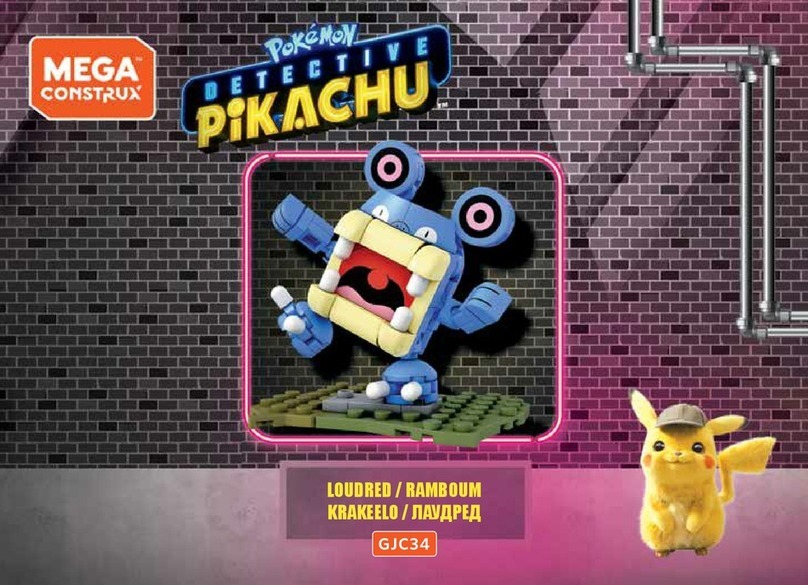
Mega Construx
Mega Construx Pokemon Detective Pikachu GJC34 manual
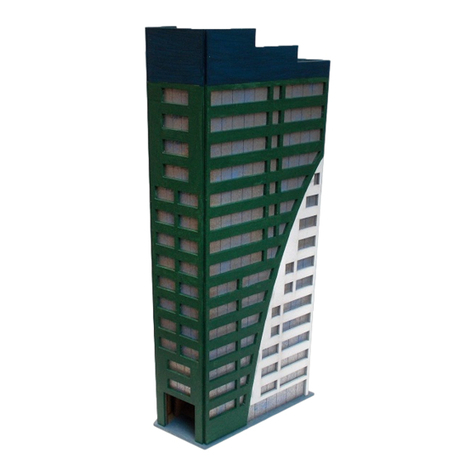
BLOTZ
BLOTZ 10mm Skyscraper Dice Tower manual
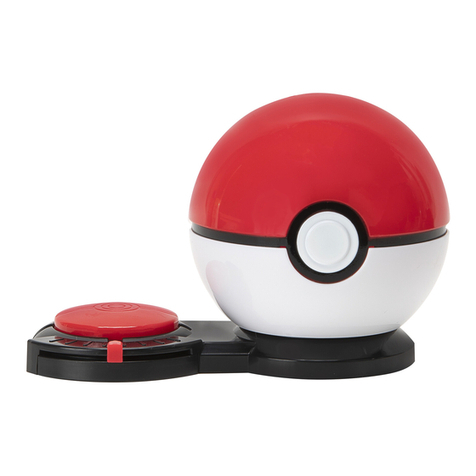
Jazwares
Jazwares Pokemon Surprise Attack Game quick guide
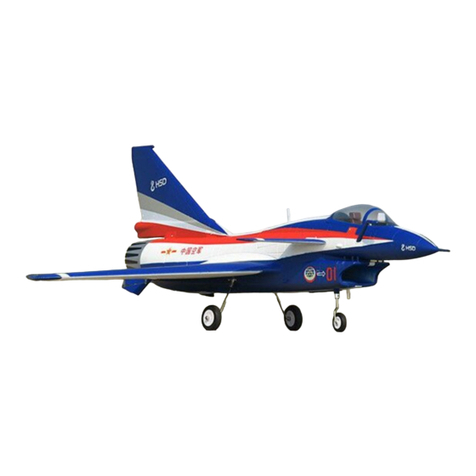
HSD
HSD J10 user manual
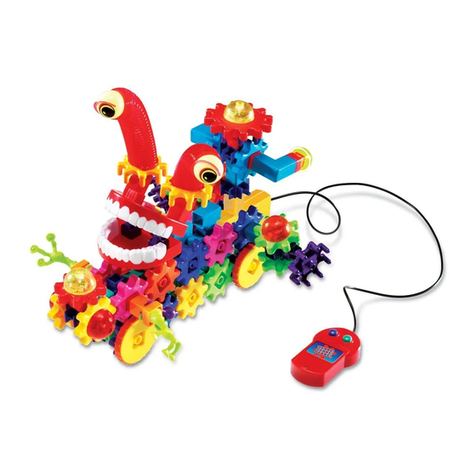
Learning Resources
Learning Resources GEARS! MOTORIZED Wacky Wigglers Building Set instructions

Faller
Faller 242 manual
